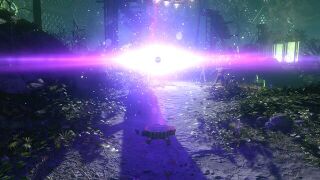The official discord link if you wish to join the discord: https://discord.gg/j5RKwCvAFu
Support the wiki on our official Ko-Fi page or Patreon page!
Black Hole: Difference between revisions
| Line 83: | Line 83: | ||
[[Category:Powers and Abilities]] | [[Category:Powers and Abilities]] | ||
{{Discussions}} | {{Discussions}} | ||
[[Category:Important]] | |||
Revision as of 02:34, 17 February 2021

Background
Black Hole Creation is a subset of Gravity Manipulation that allows the user to generate black holes, regions of space-time with gravity so intense that even light cannot escape them. True black holes are virtually inescapable unless one can move faster-than-light and ignore conventional durability because the incredible tidal forces within the black hole approach infinity in all directions, making it virtually impossible to survive through normal means unless the target is an entire dimensional tier above the user.
It should be noted that characters who have survived black holes but can otherwise be harmed by other, conventional attacks will not be given infinite durability. They will instead be stated to simply have a resistance to black holes.
It should also be noted that, even if the projectile resembles a black hole and shares the same basic function, it does not automatically qualify to be a real black hole. For further information, please refer to the section below.
Black Hole Feats in Fiction
Proving the Legitimacy of Black Holes
Often in fiction, characters will come across something they claim to be a black hole. While it may resemble one, not all verses properly treat black holes as they should. In order to ensure that something is a legitimate black hole, it should meet some of the following requirements to determine such:
- The statement comes from a reliable source.
- It should have a referenced singularity in its center.
- Light should be bent outside of just the event horizon.
- Its gravitational pull should be proportionally realistic to the black hole.
- Aspects such as spaghettification should be referenced when describing the crossovers.
- It would help to come from a source such as a dying star, something a black hole originates from.
Attack Potency for Creating Black Holes
Black holes have many special and amazing properties, but aside from the parts that can not be quantified in a number, which Attack Potency would one get for creating a black hole?
In general creating a black hole is about equal to creating any other celestial bodies. Usually creating a planet is seen as planet level and creating a star is seen as star level etc.
So how do black holes rank? The answer lies in their mass. Usually stellar black holes have masses ranging from about 5 to several tens of solar masses and can easily be assumed to be at least star level, if not large star level. But some characters also have the ability to create very small black holes and some black holes in fiction may even be extremely large. So how do we rank them?
The good thing is that there is an easy formula that lets us approximate the mass of black holes based on the radius of the event horizon. It is:
where:
- rs is the Schwarzschild radius (radius of the event horizon);
- G is the gravitational constant;
- M is the mass of the object;
- c is the speed of light in vacuum.
(From Wikipedia)
So if we know the size we can just set in all values and can easily solve to M.
To roughly estimate the Attack Potency level one can then compare its mass to either that of the earth or the sun, whichever is closer to its mass. If it's x times the mass of the object it is compared to we estimate that it's creation would equal about x times the energy needed to destroy said object, i.e. either x-times baseline planet level for earth or x-times baseline star level for the sun.
A more comfortable way may be calculators for the mass and size of a black hole such as this one or this one.
Note: Destroying a black hole is generally unquantifiable because of the unknowns of how you'd properly destroy one and the kind of energy actually needed for it. However, if there is an assigned output value for the black hole's power, you can scale the character off the AP of the black hole. The calculation process above details how we treat creating black holes.
Regarding Durability From Black Hole Feats
Black holes are generally treated as Durability Negation rather than giving outright durability to anyone. The reason is because of how spaghettification works. As you get closer to a black hole, the gravity intensifies and begins to disproportionately affect your body. The stronger tidal waves begin to distort your body the closer that you get to a singularity. For a further explanation, please read the quote below.
Escaping A Black Hole
While surviving a black hole isn't exactly quantifiable, escaping it can be a decent feat. Firstly, black holes pull in many things due to their intense gravitational poll, even light itself. In order to escape a black hole, you would need to at least be moving at faster than light speeds.
Additionally, this would require you to have the Lifting Strength to overcome its gravitational force in order to escape. Therefore, escaping a black hole also doubles as a Lifting Strength feat that varies depending on the scale of the black hole.
Unquantifiable Aspects of Black Holes
There appears to be confusion on what parts of a black hole can be used for statistics and indexing. In order to clear up confusion, the following aren't feats that should be used for anything notable:
- Grabbing/Moving a Black Hole: This is very simply impossible given how black holes work. The event horizon of a black hole is intangible, so you cannot interact with it conventionally. While you could hypothetically grab the singularity, the bizarre nature and sheer impossibility of such means it wouldn't give anything. At most, this would give Non-Physical Interaction.
- Throwing objects into the black hole to move it is also too bizarre of a feat to really know how it would apply over to Lifting Strength. While moving a black hole might be possible, the method you would actually do so is very unknown. The two listed methods here most definitely wouldn't count toward that idea.
- Surviving a Black Hole: The section above already covers this, but this is re-emphasizing for the matter of importance on a topic.
- Anything regarding faster than light Black Holes: If a black hole were to be faster than light, that would break the current understanding and logic of how black holes are supposed to even work. We can conclude that such wouldn't be a proper black hole, so it wouldn't be viable for any feats, even the aforementioned methods of calculating Attack Potency, Speed, and Lifting Strength.
- Surviving the collapse of a black hole from Hawking Radiation: Things in a black hole's grasp are hit by the negative energy of other objects rather than the actual energy when they are in the event horizon. While the character could withstand negative energy for a resistance feat, it would be unquantifiable to use for a durability feat period.
Users
- Mega Man (Mega Man)
- Sweet Tooth (Twisted Metal)
- The Gungeoneer (Enter The Gungeon)
- SCP-001 (Ouroboros/djkaktus's Proposal II) (SCP Foundation)
- Worm (Worms)
- Caliborn (Homestuck)
Credit
Discussions (Link For Mobile Users):
| Discussion threads involving Black Hole |
